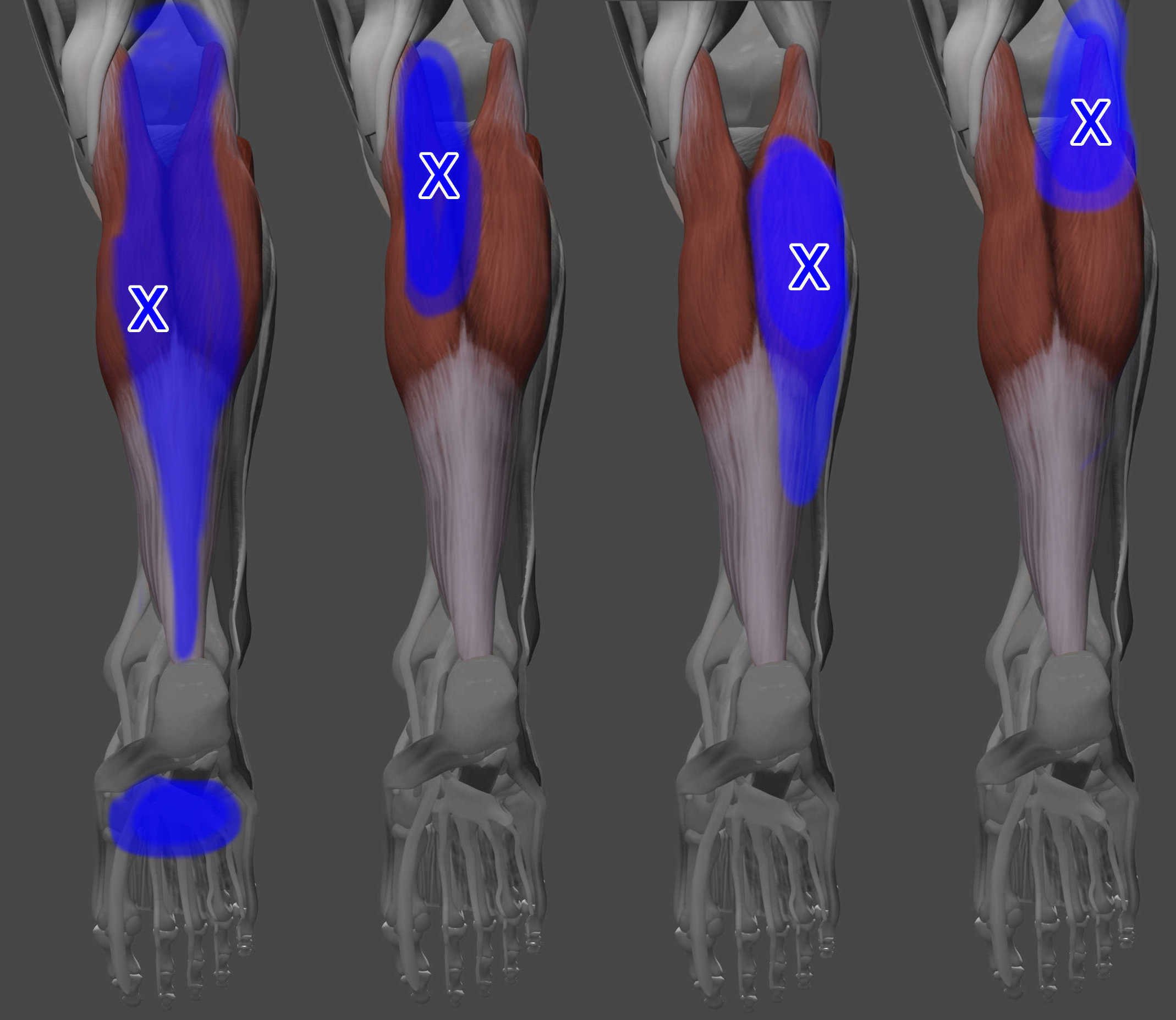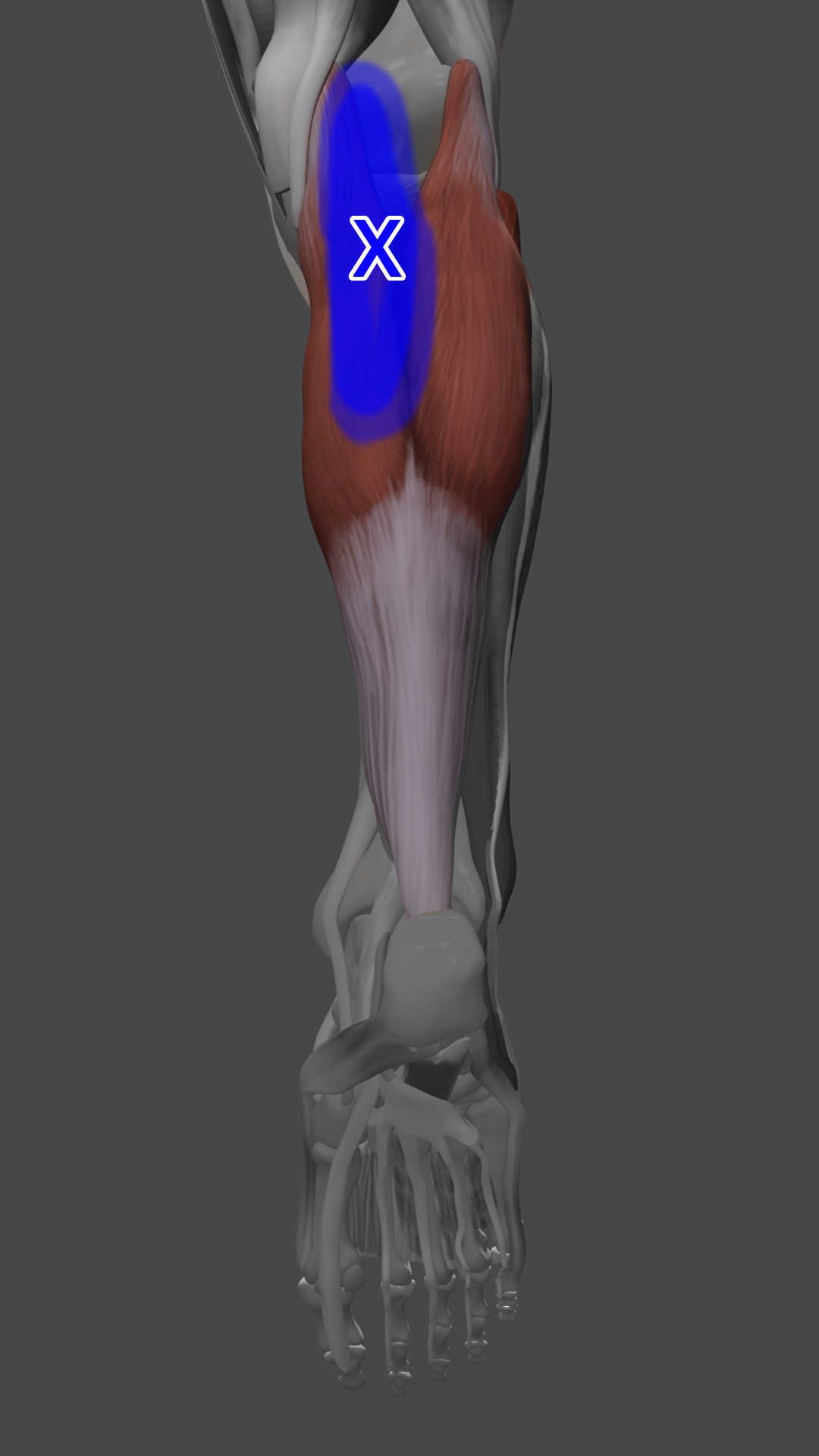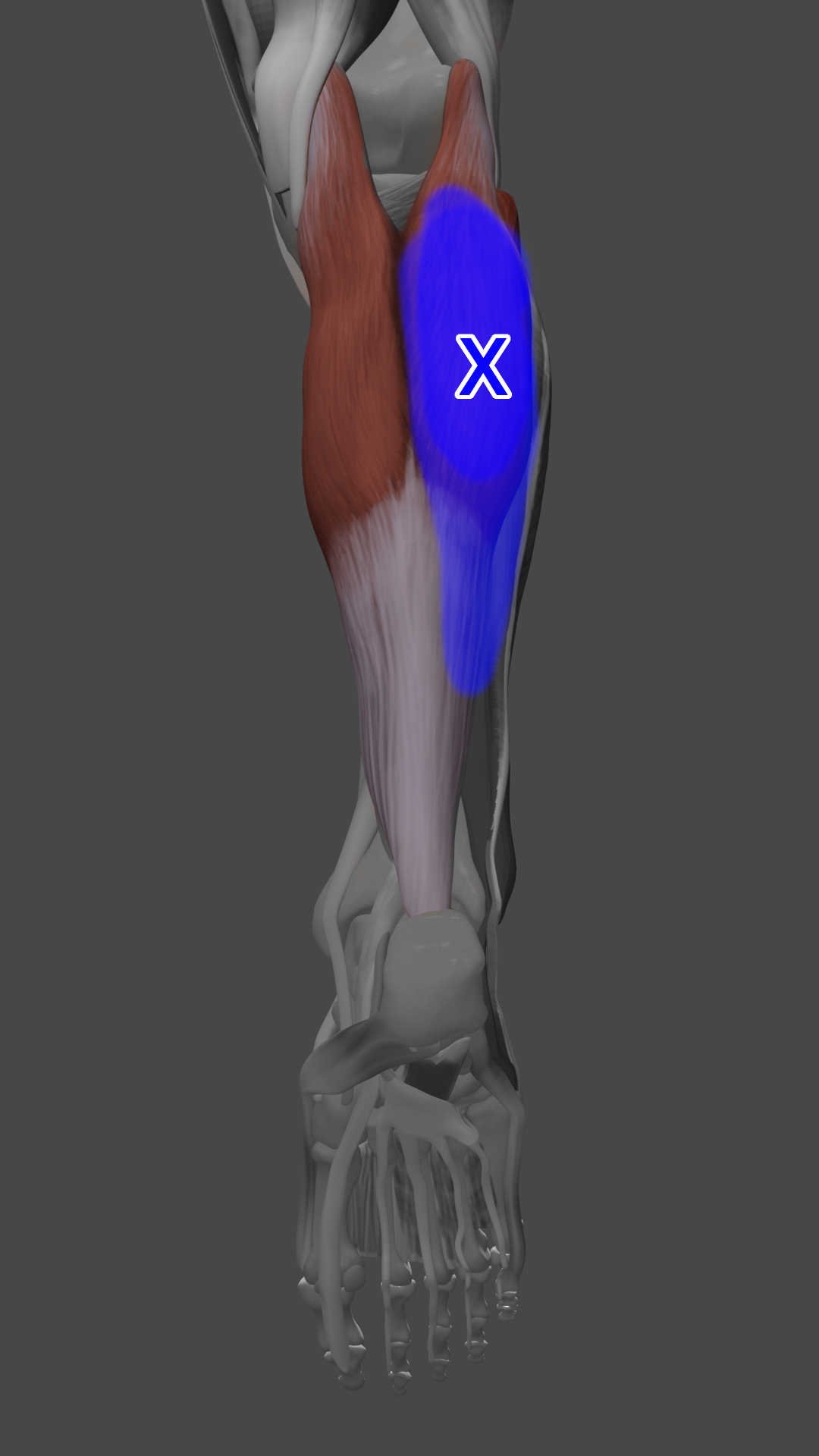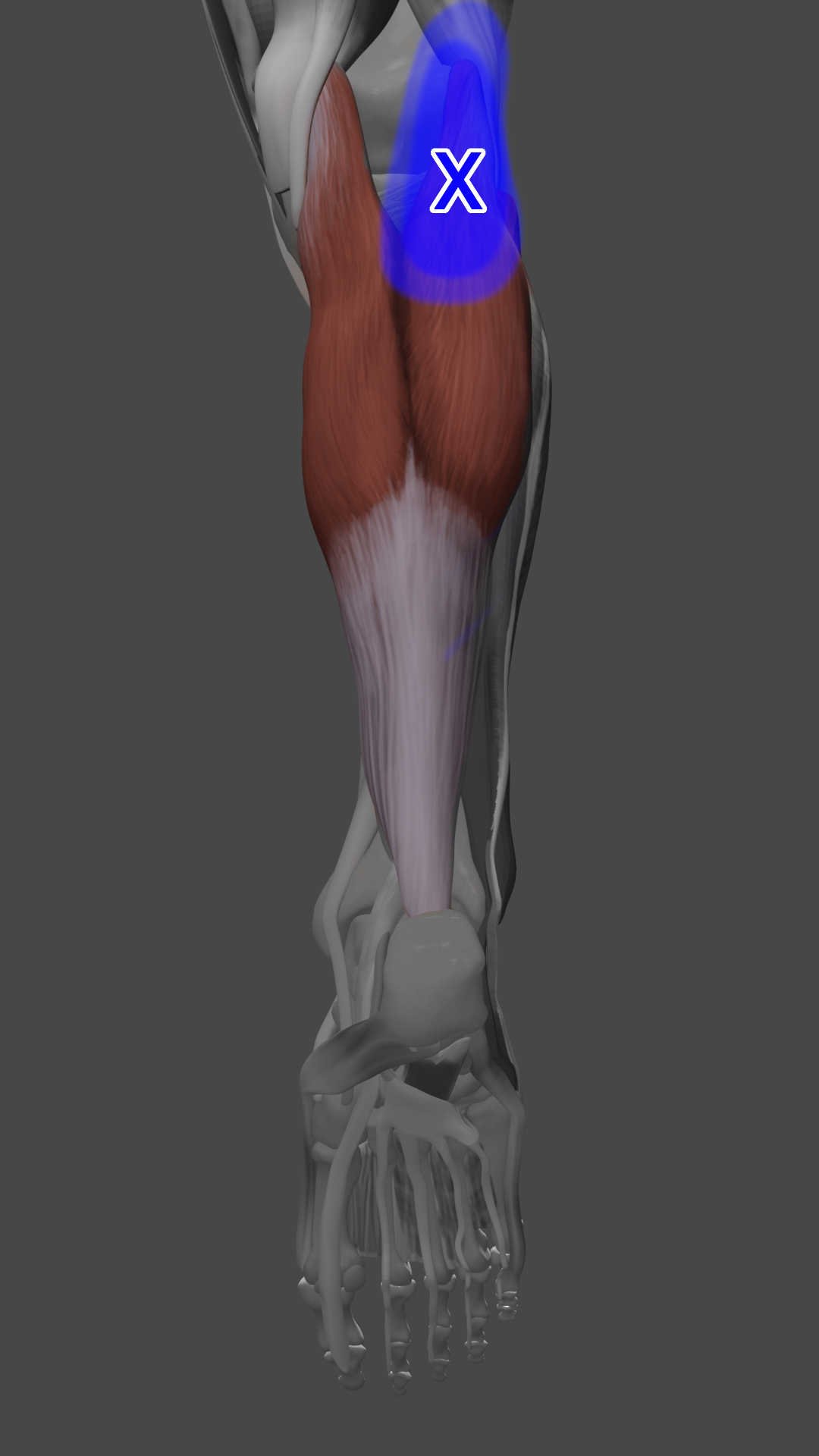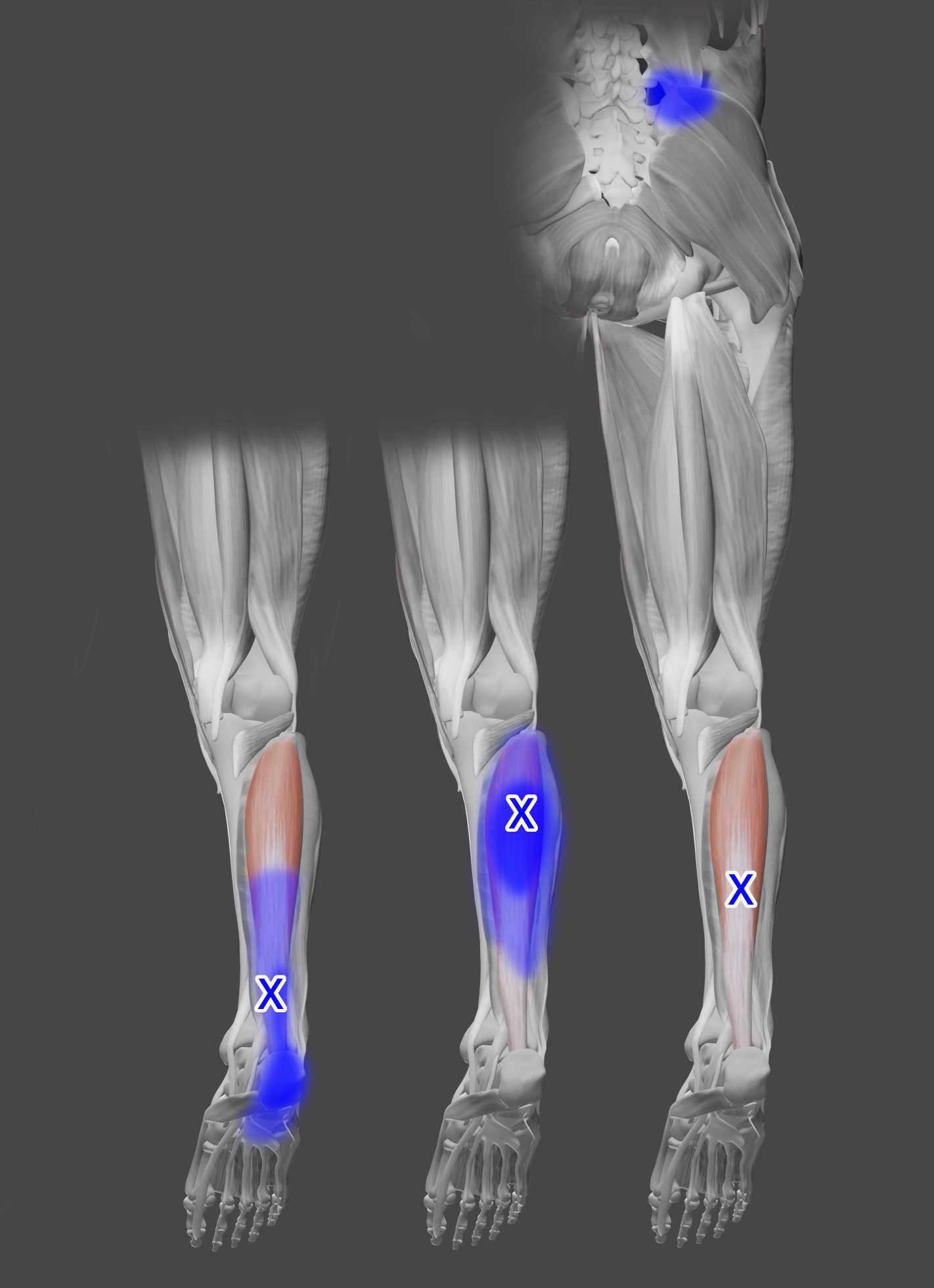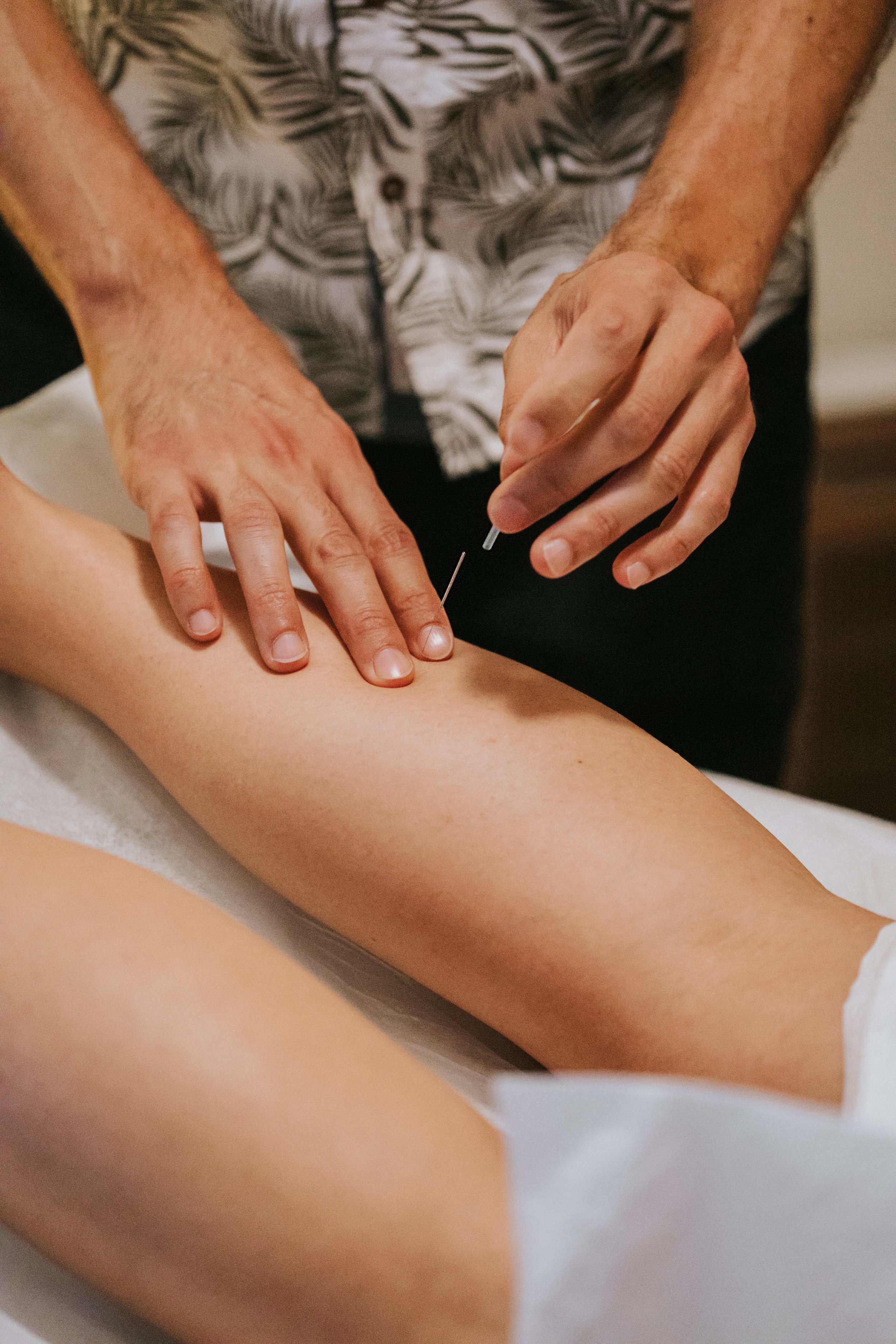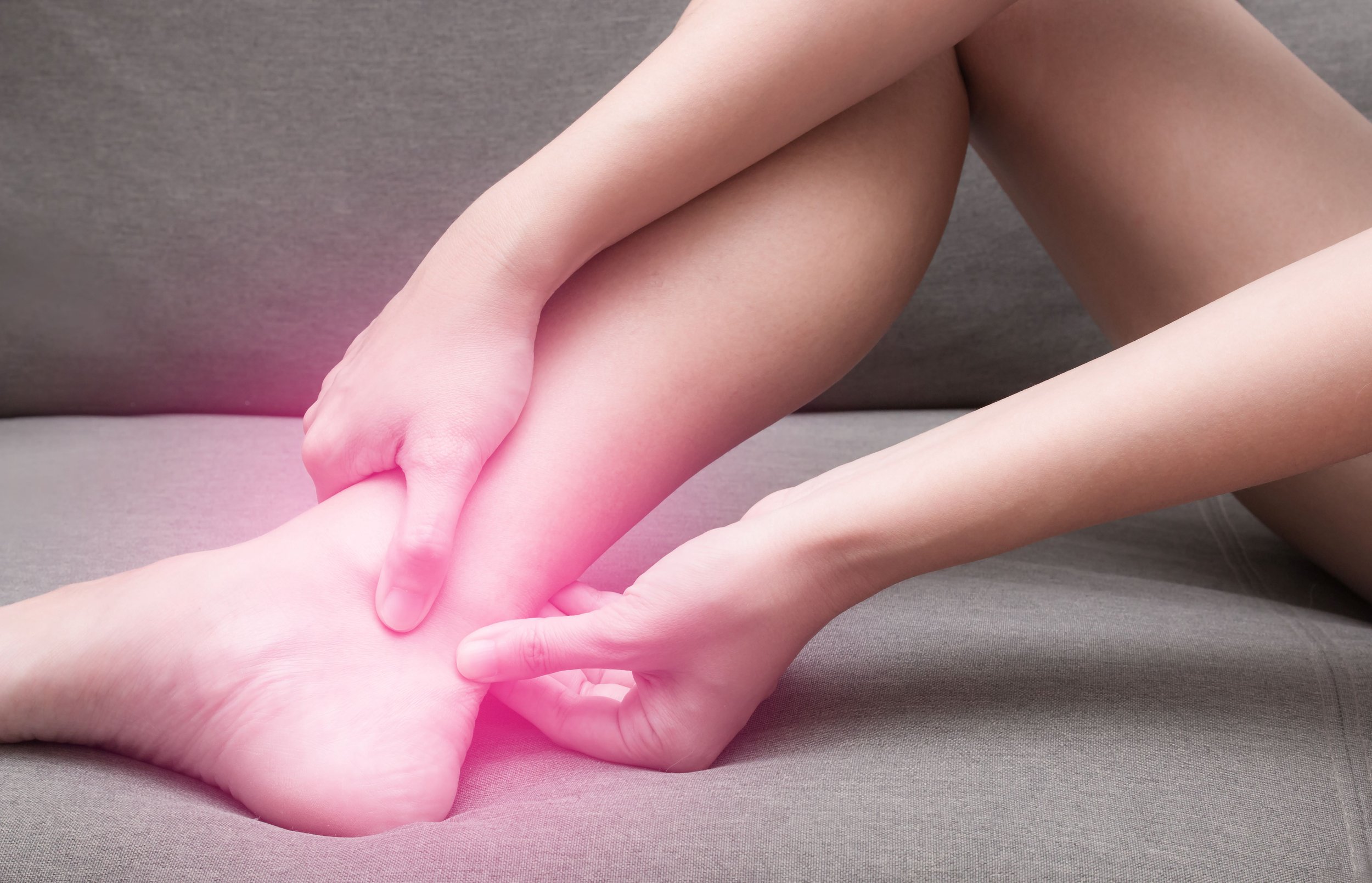Acupuncture for Calf Trigger Points
A person with calf muscle pain
How to get relief from calf muscle pain?
Do you have calf muscle pain? Do you have a gastrocnemius strain or soleus strain? Read more to learn about calf trigger points and why you should consider treating them with acupuncture and dry needling.
Calf trigger points are a common cause of lower leg and heel pain. The calf is made up of the gastrocnemius and soleus muscles on the posterior lower leg. Another name for the calf muscles (gastrocnemius and soleus) is the triceps surae muscle. Both of these muscles attach to the heel via the Achilles tendon and are commonly involved in Achilles and heel pain.
Trigger points in the calf muscles can cause a host of pain symptoms. They can be very intense and feel like a calf strain. Gastrocnemius trigger points primarily cause posterior leg and knee pain and can also cause lateral leg pain, heel and plantar foot pain, leg cramps, and restless leg syndrome. Soleus trigger points can also cause posterior leg and knee pain, restless leg syndrome, and heel/plantar foot pain. Soleus trigger points can also cause posterior ankle pain, buttock pain, and bruxism (teeth grinding).
In cases of calf cramps, the gastrocnemius is usually involved since trigger points in the soleus muscle have not been found to cause calf cramps.
Calf trigger points can be mistaken for things like Achilles tendonitis, plantar fasciitis, Baker’s cysts, heel spurs, and low back pain.
Calf muscle trigger points should be considered in cases of plantar fasciitis and Achilles tendonitis because trigger points in the gastrocnemius and soleus muscles can mimic pain symptoms of those conditions. Achilles tendon, heel pain, and bottom of the foot pain are common referral patterns of the calf muscles so these muscles should always be assessed for trigger points and myofascial constriction. Shortening of the gastrocnemius and soleus muscles from trigger points leads to more tension on the Achilles tendon and heel area.
The calf muscles are important to consider in cases of heel pain and plantar fasciitis symptoms. Studies have shown a link between gastrocnemius shortening and heel pain. Trigger points and shortening of the gastrocnemius can place increased strain on the Achilles tendon and plantar fascia which can contribute to pain symptoms in those areas.
The calf muscle also has a link to Baker’s cysts (popliteal cysts) as the cysts tend to occur on the posterior knee between the gasctronemius and semimembranosis tendons. Releasing trigger points in the gasctrocnemius and soleus muscles can help to relieve pressure on the back of the knee and allow the cyst to heal.
Soleus muscle trigger points are common in runners, because heel pain is one of the most common areas of pain in recreational runners. Since running involves excessive plantar flexion and dorsiflexion it is important to look at the gastrocnemius, soleus, as well as the tibialis anterior muscle for possible trigger points.
Soleus trigger points result in a reduction in ankle dorsiflexion which can make it more difficult to pick things up off the ground. This may result in low back pain from leaning over excessively and lifting improperly.
The pain from soleus trigger points can lead to heel tenderness that can be thought of due to heel spurs. It is important to examine and deactivate these trigger points since not all heel spurs cause heel tenderness.
Identifying and releasing active and latent trigger points in the gastrocnemius and soleus muscles is an effective way to relieve calf muscle pain and associated referral patterns to the posterior lower leg, back of the knee, Achilles tendon and heel, and bottom of the foot.
About the calf muscles
The gastrocnemius is the most superficial calf muscle with a medial head and lateral head that is responsible for the contour of the calf area. The gastrocnemius lies superficial to the deeper soleus muscle. Together they serve to provide plantar flexion to the ankle, and stabilize the knee/ankle joints.
The gastrocnemius works to stabilize and provide explosive power to the lower leg. Tension in the gastrocnemius can transmit to the foot, knee, hip, and lower back due to muscle chain and fascial connections. When there is shortening of the gastrocnemius muscle and pain from trigger points, there will be physiological changes in movement patterns through the hip that can affect how we walk or run. One study found a correlation between fascia displacement of the medial gastrocnemius muscle and mobility of the hip and hamstring muscle flexibility which shows the link between these area.
The soleus muscle is an important lower leg stabilizer muscle that has the highest proportion of type 1 slow twitch muscle fibers in the lower limb at around 70 of the muscle fibers. It is used during walking, running, jumping, and cycling. The soleus muscle acts as a musculovenous pump or “second heart” due to its pumping action which increase venous blood flow return from the lower extremities back to the heart.
Together, the gastrocnemius and soleus muscles help stabilize the knee when walking at an easy pace.
In roughly 3-5% of people there may be a third head of the gastrocnemius muscle located between the two traditional heads of the muscle and can attach onto the femur and join either that lateral or medial head at the other end.
Read more to learn about the gastrocnemius and soleus muscles (triceps surae muscle), trigger points associated with these calf muscles, and how acupuncture and dry needling can help relieve calf pain and heel pain naturally.
Origin and insertion of the calf muscles
Gastrocnemius:
The gastrocnemius origin is at the condyles of the femur, on the posterior surfaces.
The gastrocnemius insertion is at the calcaneus (heel) via the Achilles tendon (calcaneal tendon).
Soleus:
The soleus origin is at the soleal line, the proximal/posterior surface of the tibia, and the posterior aspect of the head of the fibula.
The soleus insertion is also at the calcaneus (heel) via the Achilles tendon (calcaneal tendon).
Based on the origin and insertion of the calf muscles, we can see that they pulls the lower leg and the heel (via the Achilles tendon) closer together, and primarily flex the ankle. The gastrocnemius also flexes the knee.
Actions of the calf muscles
What are the functions of the gastrocnemius muscle?
Gastrocnemius & Soleus:
Plantar flex the ankle
Gastrocnemius only:
Flex the knee
When we think of the calf muscles we can think of standing on our toes or plantar flexing the ankle. Additionally, since the gastrocnemius muscle crosses the knee, it also flexes the knee (the soleus does not).
While not commonly mentioned, Vladimir Janda also considers the soleus muscle to assist in supination of the foot due to its attachment on the medial side of the Achilles tendon.
Synergists and antagonists of the calf muscles
Calf muscle synergists include the plantaris, peroneus longus and brevis, flexor hallucis longus, flexor digitorum, and tibialis posterior muscles at the ankle. The gastrocnemus also assists the hamstrings in knee flexion with the satorius, gracilis, plantaris, and popliteus muscles.
Calf muscle antagonists include the tibialis anterior, extensor digitorum longus, and peroneus tertius. The quadriceps are also antagonists to the gastrocnemius muscle since they extend the knee.
What is another name for calf muscle?
The calf muscle is also called the triceps surae muscle and made up of the gastrocnemius and soleus muscles.
Calf Trigger Points
Main complaints related to calf trigger points include:
Gastrocnemius:
Posterior Leg (Calf) Pain
Posterior Knee Pain
Lateral Leg Pain
Plantar Midfoot Pain
Upper/Lower Leg Cramps
Restless Leg Syndrome
Soleus:
Posterior Leg (Calf) Pain
Posterior Knee Pain
Posterior Ankle Pain
Heel Pain
Plantar Midfoot Pain
Buttock Pain
Restless Leg Syndrome
Teeth Grinding (Bruxism)
The gastrocnemius is referred to as the “calf cramp” muscle by Travell & Simons, especially in cases of nocturnal calf cramps. It crosses the knee and ankle joints which explains why its pain referral patterns can span from the posterior knee down to the foot and heel.
Associated gastrocnemius trigger points include the soleus, hamstrings, toe flexors, and tibialis posterior muscles.
The soleus is referred to as the “joggers heel” muscle by Travell & Simons. Soleus trigger points may develop with gluteus minimus trigger points that can refer pain into the posterior lower leg and calf area. It also has a rare referral pattern that refers pain to the same side of the jaw - but it only occurred clinically in two patients according to Travell & Simons.
Associated soleus trigger points include the gastrocnemius, posterior tibial muscles, and long flexors of the toes (synergists). Antagonist muscles like the tibialis anterior, extensor digitorum longus, extensor hallucis longus, and peroneus tertius can also be involved and should be examined.
In addition to the triceps surae, the plantaris muscle is also present in the posterior lower leg. This muscle also attaches to the heel, via the calcaneal tendon. This is a small muscle that is less common in practice but can also cause posterior leg and calf pain, and posterior knee pain. Plantaris trigger points should also be considered in cases of calf and posterior lower leg pain. The plantaris is a weak plantar flexor of the knee and ankle since it crosses both of those joints. The plantaris muscle may be absent in anywhere from 7-20% of people and it is often dismissed as an unimportant muscle.
Gastrocnemius Trigger Point Locations
Gasctrocnemius trigger points
Medial gastrocnemius trigger points:
Gastrocnemius trigger point #1: This is the most common gastrocnemius trigger point and is located just distal to the knee close to the medial border of the medial gastrocnemius head. It refers pain to the instep of the foot and can extend to areas including the posterior thigh and knee, and down the medial portion of the back of the leg through the heel and into the bottom of the foot. This gasctrocnemius trigger point can mimic pain symptoms of Achilles tendonitis and plantar fasciitis since it refers pain to those areas.
Gastrocnemius trigger point #2: This trigger point is found in the medial, proximal portion of the muscle and refers pain locally around the medial portion of the back of the knee
Gastrocnemius trigger point #1
Gastrocnemius trigger point #2
Lateral gastrocnemius trigger points:
Gastrocnemius trigger point #3: This is the second most common gastrocnemius trigger point. It is in the belly of the lateral head of the gastrocnemius distal to the lateral knee. It refers pain locally and around the trigger point.
Gastrocnemius trigger point #4: This trigger point is found in the proximal, lateral portion of the muscle and refers pain locally around the lateral portion of the back of the knee
Gastrocnemius trigger point #3
Gastrocnemius trigger point #4
Soleus Trigger Point Locations
Soleus trigger points
Soleus Trigger Points:
Soleus trigger point #1: Most common - located in lower medial portion of the soleus muscle and refers pain to posterior plantar portion of the heel and distal Achilles tendon. Can cause heel and instep pain.
Soleus trigger point #2: Located in lateral and proximal portion of the cause and causes pain locally in upper calf.
Soleus trigger point #3: Not common - Located in lateral distal portion of the muscle slightly proximal to trigger point #1. Causes deep sacroiliac joint (SI joint) pain on the same side.
Calf Muscle Pain
Signs and symptoms of gastrocnemius trigger points
Calf cramps
Pain in calf area, back of knee, or arch area of foot
Back of the knee pain when walking on a slanted surface or climbing
What causes gastrocnemius trigger points?
Overload of muscle from intense plantar flexion
Sustained contraction or shortening of muscle, or immobility
Walking on a steep slope or slanted surface
Jogging uphill or riding a bike with the seat too low
Lower leg or ankle injury that requires wearing a cast
Standing while leaning forward for long period of time - like washing dishes, wearing heels, standing at a desk for work
Driving long distances
Impaired circulation
Long socks with tight elastic band at the top
Signs and symptoms of soleus trigger points
Tenderness that refers pain to the heel
Difficulty placing weight on affected foot
Pain at night
Swelling of foot and ankle
Restricted dorsiflexion of the ankle
Difficulty walking up and down stairs or uphill
What causes soleus trigger points?
Overuse from excessive toe-off
Jogging
Wearing high heels or shoes that cause slipping forward
Direct trauma to the area
Skiing or skating without ankle support
Impaired circulation
Leg length discrepancy
What is the treatment for calf muscle strains and trigger points?
Trigger point dry needling acupuncture treatment for calf trigger points
How can I reduce calf muscle knots?
Trigger point acupuncture and dry needling can provide myofascial release in the calf muscles by identifying the taut bands of muscle that create the pain referral pattern and eliciting a twitch response with an acupuncture needle to relax the muscle to restore function, improve range of motion, and reduce pain. Some gastrocnemius and soleus trigger points can be deep and inaccessible without the use of an acupuncture needle.
Your acupuncturist will palpate for taut bands of muscle to find trigger points in the calf and then release the calf muscle knots with the acupuncture needle. These trigger points can mimic a gastrocnemius strain or soleus strain and be very painful Trigger point dry needling for the calf muscles can release the trigger points and is one of the most effective ways to relieve pain in these muscles.
Other modalities like electroacupuncture, cupping, gua sha, and tui na can also help with posterior lower leg, heel, and posterior knee pain symptoms.
Gastrocnemius Corrective Exercises
Posture:
Avoid high heels
Avoid excessive driving, due to the strain on the accelerator foot
Have good foot support when sitting and limit use of high stools
Activities and things to avoid for calf cramps:
Keep calf area warm
Avoid too much uphill walking
Avoid walking on slanted surfaces
Avoid excessive kicking with toes pointed like when swimming
Avoid tight elastic band on socks over the calf
Avoid prolonged plantar flexion of foot
Treating calf cramps:
Inactivate calf trigger points
Ensure foot support when seated
Perform appropriate mobility and strengthening exercises
Perform appropriate calf muscle stretches
Other muscles involved calf muscle pain symptoms:
Posterior Leg (Calf) Pain
Soleus
Gastrocnemius
Semimembranosus
Flexor Digitorum Longus
Tibialis Posterior
Plantaris
Posterior Knee Pain
Gastrocnemius
Popliteus
Plantaris
Semitendinosus
Semimembranosus
Soleus
Lateral Leg Pain
Gastrocnemius
Peroneus Longus
Peroneus Brevis
Vastus Lateralis
Posterior Ankle Pain
Soleus
Tibialis Posterior
Heel Pain
Soleus
Quadratus Plantae
Abductor Hallucis
Tibialis Posterior
Plantar Midfoot Pain
Gastrocnemius
Flexor Digitorum Longus
Abductor Hallucis
Soleus
Interossei of Foot
Abductor Hallucis
Tibialis Posterior
Upper/Lower Leg Cramps
Gastrocnemius
Sartorius
Restless Leg Syndrome
Soleus
Gastrocnemius
Buttock Pain:
Gluteus Maximus
Iliocostalis Lumborum
Longissimus Thoracis
Semitendinosus
Semimembranosus
Piriformis
Rectus Abdominus
Soleus
Teeth Grinding (Bruxism)
Digastric
Masseter
Soleus
Over to you
If you liked this article, please share with friends and family who may be suffering with calf pain, knee pain, or heel pain:
Sources:
Travell, J. G., Simons, D. G. (1993). Myofascial pain and dysfunction: The trigger point manual (Vol. 2). London: Lippincott Williams & Wilkins.
Biel, A., & Dorn, R. (2010). Trail guide to the body: A hands-on guide to locating muscles, bones and more. Boulder, CO: Books of Dicovery.
Cruz-Montecinos C, González Blanche A, López Sánchez D, Cerda M, Sanzana-Cuche R, Cuesta-Vargas A. In vivo relationship between pelvis motion and deep fascia displacement of the medial gastrocnemius: anatomical and functional implications. J Anat. 2015 Nov;227(5):665-72. doi: 10.1111/joa.12370. Epub 2015 Sep 10. PMID: 26467242; PMCID: PMC4609201.
Solan MC, Carne A, Davies MS. Gastrocnemius shortening and heel pain. Foot Ankle Clin. 2014 Dec;19(4):719-38. doi: 10.1016/j.fcl.2014.08.010. Epub 2014 Oct 3. PMID: 25456718.
Demange MK. BAKER'S CYST. Rev Bras Ortop. 2015 Nov 16;46(6):630-3. doi: 10.1016/S2255-4971(15)30317-7. PMID: 27027065; PMCID: PMC4799332.
Bazzoli AS, Pollina FS, Johnson EW. Heel Pain in Recreational Runners. Phys Sportsmed. 1989 Feb;17(2):55-61. doi: 10.1080/00913847.1989.11709704. PMID: 27452016.
Edgerton VR, Smith JL, Simpson DR. Muscle fibre type populations of human leg muscles. Histochem J. 1975 May;7(3):259-66. doi: 10.1007/BF01003594. PMID: 123895.
Iwai T, Sato S, Yamada T, Muraoka Y, Sakurazawa K, Kinoshita H, Inoue Y, Endo M, Yoshida T, Suzuki S. Popliteal vein entrapment caused by the third head of the gastrocnemius muscle. Br J Surg. 1987 Nov;74(11):1006-8. doi: 10.1002/bjs.1800741117. PMID: 3690223.
Spina AA. The plantaris muscle: anatomy, injury, imaging, and treatment. J Can Chiropr Assoc. 2007;51(3):158-65. PMID: 17885678; PMCID: PMC1978447.
Janda, Vladimír. “Muscle Function Testing.” (1983).

